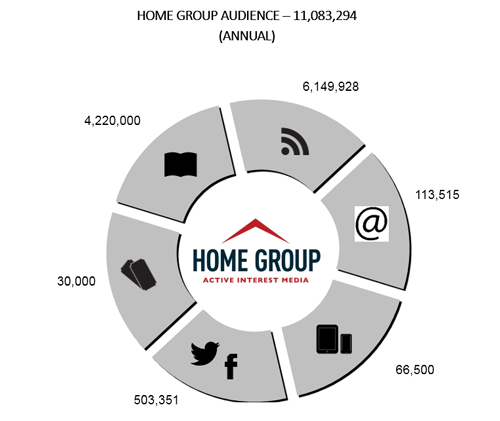
Peter Miller
How Media Works
Old house and traditional building market research tells us a lot about how media works to serve the needs and interests of old house owners, new period home buyers, as well as traditional building architects, interior designers and builders. Different types of media: magazines; web sites; social media; e newsletters; videos and trade shows connect with our clients at different points in their discovery journey.
WHICH media works? That’s a question we get asked every day, especially now that there are so many different media options. The answer begs another question: “is there a magic bullet? Can one media methodology, above all else, connect with everyone all the time?”
With all the hype about social media it would seem as if Houzz, Pinterest or Twitter are the panacea, capable of inspiring, educating and convincing our clients all at once. Social media is important but it can’t act alone. It takes an integrated media mix to do all this.
When a client or prospect is passionate about building, decorating, restoring or renovating a historic building, he or she will read, collect, engage and consume as much information as possible, in as many ways as are available. People do have their favorite information sources but all credible sources are important when someone is “in the market” for designing, building or remodeling.
The chart below shows you how many readers engage with each different media delivery method in the Home Group old house and traditional building media portfolio. Each media option: print; web; email; digital magazine editions; social media and in-person events has its own constituency and there is overlap between readers, visitors, followers and attendees. Your clients and ours, engage with us throughout their discovery journey. Their interaction with our content is often determined by where they are in the journey “funnel.”
At the top of the funnel below, buyers look for ideas and inspiration. They probably don’t know what they want yet, so they rely on you and me to get their wheels turning. At this stage, clients prefer print magazines because of their visual brilliance and ideas overview. Readers tell us that magazines provide design and product “inspiration” for getting started on a building and design project. They tear out pages and keep them in an idea folder.
Further into their discovery journey our mutual clients do research. This is where the web is so useful. It allows clients to search what they are looking for. Buyers and enthusiasts spend a lot of time on our web sites and yours, but usually not until they have some idea about what they want. As they build their body of knowledge they look to email or e casts to keep them current, consistently, over time. Now that their immersion is underway they might also look for a richer interactive experience on the magazine’s digital editions or on videos.
Social media helps create a buzz, some word of mouth and it augments a conversation already begun. It gives your clients and prospects something to talk about. TV and video can help you hold the client’s hand with how-to content, thus building more confidence and trust.
In-person events are often at the end of the client’s discovery journey. Here, they want to meet you, shake your hand and look you in the eye before doing business with you. Hopefully by now, they have learned enough about you, via magazines; web sites; email; digital downloads; social media and videos that they trust you.
In today’s climate of uncertainty, client trust is not just important, it is required. A good way to build this client trust is to engage with them at every stage of their journey and help them discover you.
Peter H. Miller, Hon. AIA, is the publisher and President of TRADITIONAL BUILDING, PERIOD HOMES and the Traditional Building Conference Series, and podcast host for Building Tradition, Active Interest Media's business to business media platform. AIM also publishes OLD HOUSE JOURNAL; NEW OLD HOUSE; FINE HOMEBUILDING; ARTS and CRAFTS HOMES; TIMBER HOME LIVING; ARTISAN HOMES; FINE GARDENING and HORTICULTURE. The Home Group integrated media portfolio serves over 50 million architects, builders, craftspeople, interior designers, building owners, homeowners and home buyers.
Pete lives in a classic Sears house, a Craftsman-style Four Square built in 1924, which he has lovingly restored over a period of 30 years. Resting on a bluff near the Potomac River in Washington, D.C., just four miles from the White House, Pete’s home is part of the Palisades neighborhood, which used to be a summer retreat for the District’s over-heated denizens.
Before joining Active Interest Media (AIM), Pete co-founded Restore Media in 2000 which was sold to AIM in 2012. Before this, Pete spent 17 years at trade publishing giant Hanley Wood, where he helped launch the Remodeling Show, the first trade conference and exhibition aimed at the business needs and interests of professional remodeling contractors. He was also publisher of Hanley Wood’s Remodeling, Custom Home, and Kitchen and Bath Showroom magazines and was the creator of Remodeling’s Big 50 Conference (now called the Leadership Conference).
Pete participates actively with the American Institute of Architects’ Historic Resources Committee and also serves as President of the Washington Mid Atlantic Chapter of the Institute of Classical Architecture & Art. He is a long-time member of the National Trust for Historic Preservation and an enthusiastic advocate for urbanism, the revitalization of historic neighborhoods and the benefits of sustainability, including the adaptive reuse of historic buildings.








